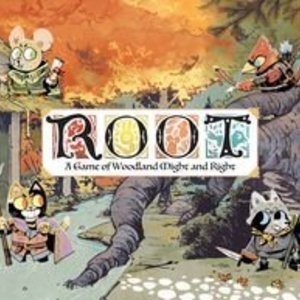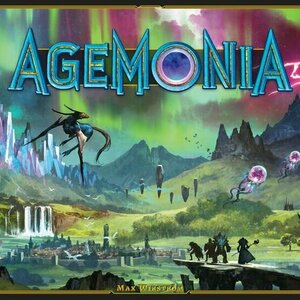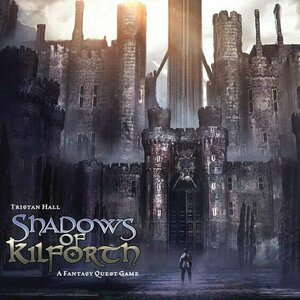
Color by Numbers - Halloween
Games and Education
App
Every year, boys and girls all over the world eagerly await Halloween. For on this night, the most...

Noddy Toyland Detective - Let's Investigate
Education and Games
App
Join Noddy as Toyland’s most famous detective in an adventure filled with storytelling, learning...

Onitama
Games
App
Immerse yourself in an ancient Japanese setting and discover Onitama, an exciting, fast-paced...
Boardgames BoardGameApps GreatGames

Root
Tabletop Game
Root is a game of adventure and war in which 2 to 4 (6 with the 'Riverfolk' expansion) players...
Boardgames 2018Games
Purple Phoenix Games (2266 KP) rated Shadows of Kilforth: A Fantasy Quest Game in Tabletop Games
Sep 3, 2020
Shadows of Kilforth is subtitled, “A Fantasy Quest Game.” Right there in the title you find out exactly what you are up against in the very foreboding but unassumingly-sized box. A game set in a fantasy world that is focused on questing. I have to admit up front that this review will be treated a little differently as the rulebook is hefty and nobody wants to read a thorough rules essay on Shadows. So I will give you a very high-level overview of the main steps and then give you my thoughts on how it all works together.
DISCLAIMER: We were provided a copy of this game for the purposes of this review. This is a retail copy of the game, so what you see in these photos is exactly what would be received in your box. I do not intend to cover every single rule included in the rulebook, but will describe the overall game flow and major rule set so that our readers may get a sense of how the game plays. For more in depth rules, you may purchase a copy online or from your FLGS. -T
Shadows of Kilforth is essentially a card and dice RPG-esque adventure game with an Asian-style theme but set in a fantasy world where locations will be devastated into gloom (building upon the first in the series Gloom of Kilforth). The players, as the heroes, have the daunting task of journeying throughout Kilforth’s 25 locations to collect items, allies, spells, and titles to overcome main quests and subquests before every location falls into gloom. These quests usually have the players gathering specific card types to satisfy and complete. Once main player storyline quests, called Sagas, are completed the hero levels up and when they complete their fourth quest in their main Saga they may attempt their Finale and then may finally assault the big boss, the Ancient.
Each turn players have Action Points (AP) to spend on doing different actions: movement, discovering rumours (yes, I know it’s the Queen’s English), confrontations, and regaling a Saga chapter, among several others. Some actions are free actions, called Deeds. These include resolving loot tokens, assaulting an ancient, exchanging items between players, and several others. By using combinations of Actions and Deeds players will be able to travel around collecting those items, allies, and so forth needed to complete their Saga chapters.
To complete objectives and quests, players will typically be rolling dice to meet requirements on the cards. This, as all role-players know, can be either supremely lucky or incredibly and predictably debilitating. Skill checks are abundant in Shadows and diversifying characters may or may not have advantages by being able to complete Fight, Study, Sneak, and Influence tests. Players will win if they can complete their Sagas and defeat the Ancient before all of the locations fall into gloom, signaling the end of the game.
All this, again, is very high-level and there are many intricacies in Shadows that I just cannot go over for the sake of time and the health of my typing fingers. But, the game can be played solo, cooperatively, or competitively. So depending on the mode of play and number of players Shadows can range from a 45 minute foray to multi-hour epics. This is why I have played this solo with one character for my plays.
Components. Shadows of Kilforth is very card-heavy, but also includes other goodies. The cards themselves are firstly quite numerous, but also good quality. I can see myself sleeving this and loving every minute of that process. Aside from the cards, the game includes standees for player pieces on the card map, wooden components to track HP, AP, Fate, Obstacles, Gold, Hidden characters, great swirly 6d6, and also cardboard chits for Loot tokens. I haven’t even mentioned the art yet and that may be the most stunning component in this game! I LOVE a game with great art, and Shadows has simply amazing art. This is not usually my style of game art either, but it is so pleasing and everything makes sense and gets me immersed in the game. Everything provided is wonderful quality and an absolute joy to use during play.
Ok so like always, we place our ratings graphic right at the top of our posts so our readers can see right away what we think of the game. As you can tell, I love Shadows of Kilforth. It has essences of so many games I enjoy pieced together in a very attractive and captivating package. The movement and subsequent destruction of map-cards are reminiscent of Forbidden Island/Desert and Tiny Epic Defenders, which I really love (don’t hate – it’s a good game). The gathering of select card types and returning to a location to complete feels like fetch quests in MMORPGs (Final Fantasy XI being my main squeeze for many years). Obviously dice skill checks and level ups from tabletop RPGs are in there as well.
Shadows is just such a great collection of mechanics that I love that I can see myself playing this game over and over and over. Caveat: I will never play this any way other than absolutely solo. My first play, yes a learning session, was just shy of two hours from setup to tear-down. Adding players will increase game length, and playing with AP-prone friends is a no-go for me on Shadows; I had to reference both the excellent provided cheat sheet and the rulebook throughout the play but I eventually got the hang of it and was able to fly through. I may play this solo but with multiple characters cooperatively someday, but I do not wish to play this with other people. Ever.
So here’s my final thought. Shadow of Kilforth is a beefy game, but is well worth the time and effort to learn and play a couple times before passing judgment. It has everything I love in a game and I can’t stop thinking about it. I want to play all the different Race/Class combinations and just dunk on all the Ancients. If only my dice didn’t hate me so much. I will certainly be keeping this one forever, and if you are a fan of fantasy themed adventure card games with heavy use of dice and cool components, DEFINITELY take a look at Shadows of Kilforth. As I am the only one who has played this, I speak for the team in saying Purple Phoenix Games gives this one a 6 / 6. Treat yoself to this one, folks.
Beckie Shelton (40 KP) rated The Shimmering in Books
May 28, 2017
This was my main reason for wanting to read this novel and I have to admit I was also looking for something light, fluffy and just easy to read, a bit of romantic instalove to warm the old heart, sigh.
And The Shimmering does all that, you get exactly what it says on the tin.
This was an ok read, not amazing, but it passed a few hours and was enjoyable in an easy non-brain taxing way.
Basically, you have our intrepid heroine journalist Sandra Lowell testing out an astral projecting machine for a story.
This device manages to, with a little help from an ancient Totem the Zorash, to send Sandra across the universe and into the body of a woman about to be married to Daveck. Daveck is intent on marrying his enemies daughter to force her to reveal the location of the same object that has helped propel Sandra here to his planet from across the stars.
So what worked for me and what didn't.
well, I felt that the storyline here is so imaginative that much more could have been done to expand on this, I would have liked to see this more of this new world, to explore and meet its alien people properly.
Sandra also seemed a lot more fleshed out than Daveck, who I really struggled to get a fully dimensional picture of and to connect with, also I'm all for instalove but I felt that Sandra after lamenting all through earlier chapters why she didn't have a man and how important her career was gave up that job unbelievably fast.
Now that is out of the way, why should you read The Shimmering?
Well, This is a charming uncomplicated tale of instalove across the stars, it's very imaginative and though it's a simple angst-free story it does kind of give you a warm nostalgic glow, This wasn't quite a three for me but a two seemed too low so I've rated this 2 1/2 on the Goodreads rating I would have rated it slightly higher if I was able to connect more with the book's characters, for me this was an ok read that pleasantly passed the time.
Thank you to the publisher and NetGalley for providing me with a free readers copy of the Shimmering. This is my own unbiased opinion.
Arc Reviewed By BeckieBookworm
https://www.beckiebookworm.com/
https://www.facebook.com/beckiebookworm/
https://www.goodreads.com/user/show/9460945-bex-beckie-bookworm

Altered Beast Classic
Games, Entertainment and Stickers
App
Venture into the underworld in SEGA’s legendary beat ‘em up Altered Beast, now available on...

Chambers Dictionary of Great Quotations
Book
With over 25,000 quotations from over 4,000 sources, The Chambers Dictionary of Great Quotations is...



